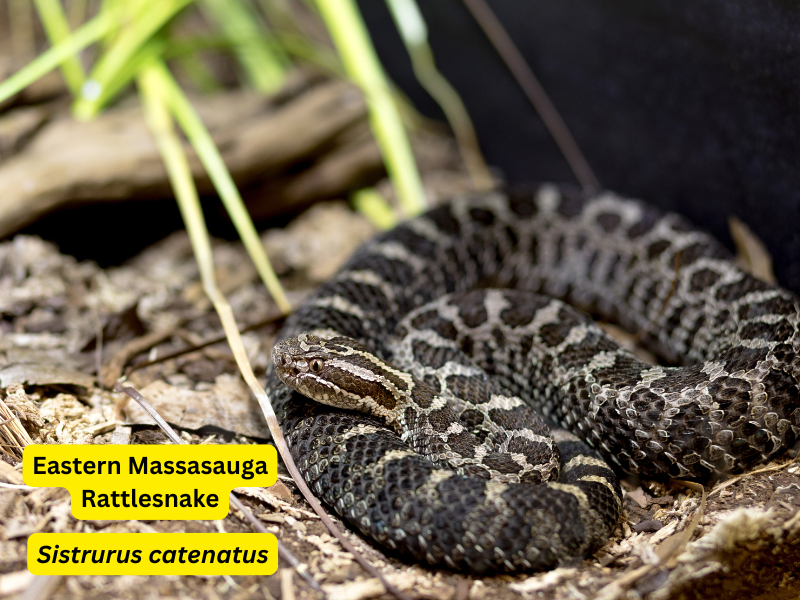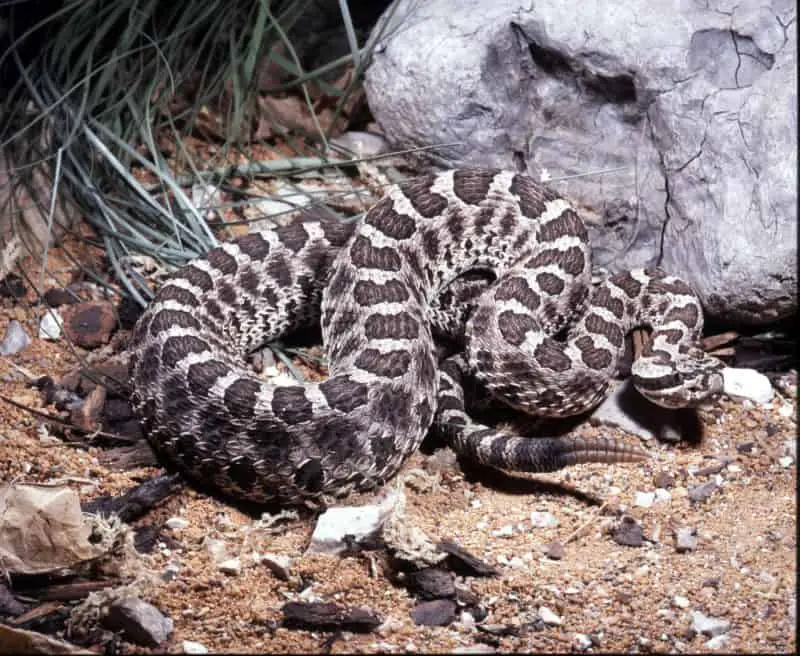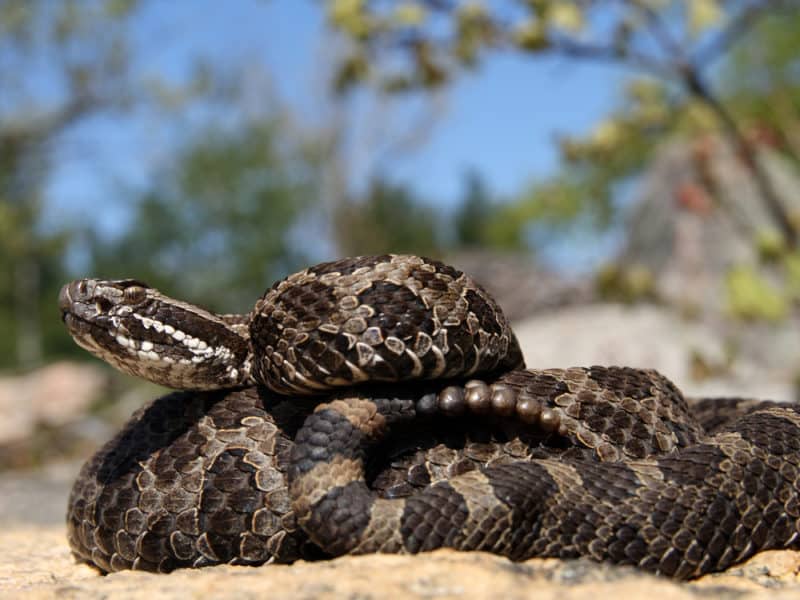The Eastern Massasauga Rattlesnake is the only venomous snake species in Michigan. The State is one of the last strongholds for these endangered pit vipers.
Anyone who spends time outdoors in Michigan will be safer if they learn all they can about these snakes. Eastern Massasaugas bite around 58 people in Michigan in an average year.
This guide is designed to give you detailed information on where Eastern Massasauga Rattlesnakes live in Michigan, how to recognize them, and how to avoid conflicts with them.
Pit Vipers: The Venomous Masters of Infrared Detection
Rattlesnakes, Copperheads, and Cottonmouths are the snakes in the United States that belong to the Crotaline subfamily of the venomous Viperidae family, also referred to as pit vipers. Since the Eastern Massasauga Rattlesnake is a pit viper, let’s learn more about them.
What Makes Pit Vipers Unique?
- Infrared-Sensing Pits:
A defining feature of pit vipers is the deep facial pit between their nostril and the eye on each side of their head. These specialized infrared-detecting organs allow pit vipers to sense heat emitted by prey. This adaptation enables them to:- Detect body heat from up to 1 meter away.
- Strike prey with pinpoint accuracy, even in complete darkness.
- Triangular Heads and Vertical Pupils:
- Head Shape: Pit vipers are recognized by their distinct triangular-shaped heads, which house their venom glands.
- Eyes: They have vertical elliptical-shaped pupils.
- Venomous Fangs:
Pit vipers have hollow fangs connected to venom glands. These fangs fold back against the roof of their mouth when not in use. All pit vipers are born with multiple fangs and replace them every couple of months. Old fangs are shed one at a time. Consequently, a pit viper bite may only involve one fang. - Pit Viper Bites: Interestingly, these snakes have a sphincter on each venom gland. This allows them to control the flow of venom through the fangs. A snake may elect not to inject any venom with a bite. Scientists surmise this is because rebuilding its venom store takes time. Twenty to twenty-five percent of pit viper-to-human bites are dry bites.
Ecological Importance
Pit vipers play a crucial role in maintaining ecosystem balance by controlling rodent populations. Despite their fearsome reputation, these snakes are vital to the health of many habitats.
Rattlesnakes
What Michigan’s Eastern Massasauga Rattlesnakes have in common with most rattlesnakes is the rattle at the ends of their tails.
- Most rattlesnakes have a rattle at their tail’s end, comprised of hollow, loosely interlocked keratinous scales.
- Normally, a rattlesnake adds a new segment to its rattle each time it sheds its skin.
- An agitated rattlesnake rapidly vibrates its tail, causing the segments of its rattle to vibrate together, creating a buzzing or rattling sound.
- An Eastern Massasauga’s rattle is more of a buzzing sound, very similar to the buzzing of a bee.
- Not all Eastern Massasaugas rattle before they strike. Sometimes, they lose their rattles due to injury, and sometimes, they choose not to rattle.

Eastern Massasauga Rattlesnakes (Sistrurus catenatus)
Massasaugas have a high-pitched rattle sound, which is different from other rattlesnakes. This is why they have the nickname Buzztail.
| Size | *Adult Eastern Massasaugas average 22 to 30 inches (55 to 75cm) long. |
| Coloration | *Their base color is light grey. *Some melanistic snakes are almost entirely black in color. |
| Dorsal Spots | *A row of large, rounded, blackish-brown spots run down their spine. *They have three smaller rows of spots down each side. *In some cases, the larger dorsal spots connect with the side spots, forming a large solid blotch. |
| Head | *A dark stripe on each side of their face and across their eye. |
| Conservation Status | *Species of special concern in Michigan. |
Snakes That Resemble the Eastern Massasauga
The Eastern Fox Snake and Eastern Milk Snake are non-venomous snakes in the Great Lakes region. Both have color patterns similar to those of Eastern Massasauga. Also, the mildly venomous Eastern Hog-Nosed Snake varies in appearance and can sometimes resemble an Eastern Massasauga.
Where Do Eastern Massasauga Rattlesnakes Live in Michigan?

Eastern Massasaugas are native to every county in the lower peninsula of Michigan. But they have never been found on the mainland of the Upper Peninsula. However, they inhabit parts of Bois Blanc Island in Mackinac County. This is according to the Michigan Department of Natural Resources.
The Eastern Massasauga is native to the Great Lakes region. Michigan is one of the last strongholds for the Eastern Massasauga. The state has more Eastern Massasaugas than any other state or province in the species’ range.
In the spring and fall, Eastern Massasaugas prefer a variety of wetland habitats. In southern Michigan, they gravitate to prairie fen environments. Further to the north, they are most apt to be found in lowland wooded areas such as cedar swamps.
During the summer, these snakes generally move to higher ground where it’s drier. You might find them in forest openings or the grassy areas between farm fields.
They return to areas with year-round wetlands in the fall before entering brumination.
Wintertime Brumation
Snakes do not tolerate cold winters very well. They are ectotherms, which means they cannot regulate their body temperature internally. Physiologically, ectotherms cannot hibernate. Yet, they go into a state of suspended animation called brumation for up to 6 months out of the year.
Some snakes spend the winter in communal dens. Eastern Massasaugas do not. These snakes spend the winter alone or in groups of two or three. They use places such as burrows of small animals or crayfish as hibernacula over the winter.
Only about 70% of adults and 38% of neonate Eastern Massasaugas survive from year to year. Many of the mortalities that occur take place over the winter.
Studies have also shown that these snakes have a strong site affinity. They tend to overwinter in the same spot every year. These studies suggest that relocated massasaugas often struggle to survive winter. This is because they have a hard time selecting a new denning site.
Threats Facing the Eastern Massasauga Rattlesnake are Habitat Loss and Disease
The biggest threat facing the Eastern Massasauga is the loss and fragmentation of prairie fen and wetland habitat.
There’s also a fungal disease called ophidiomycosis. It’s a threat to Eastern Massasaugas throughout their range. This disease has a mortality rate of greater than 90% in infected individuals.
Eastern Massasaugas are listed as threatened species under the Federal Endangered Species Act. This assesses the viability of the species in their entire range in the United States and Canada.
Their population is declining in Michigan, too, though. Even in the Wolverine State, they are a species of special concern. A chief cause of their decline is habitat loss and fragmentation of critical habitat.
Protecting Michigan’s Eastern Massasauga Rattlesnakes
The Eastern Massasauga Rattlesnake is Michigan’s only venomous snake. It plays a vital role in its wet prairie habitats. However, this timid and endangered species faces numerous threats, making conservation efforts critical.”
The John Ball Zoo of Grand Rapids actively supports Eastern Massasauga conservation. They do this through field studies and a captive breeding program.
They are involved in a long-term Eastern Massasauga monitoring program. Their partners in this project are other zoos, the Michigan DNR, and the U.S. Fish and Wildlife Service.
Teams head into Michigan’s wet prairies every spring to tag Eastern Massasaugas. To date, they have tagged over 400 snakes. Tagging these snakes gives researchers a window into their habits and movements.
The zoo is also partnered in a study with Sarett Nature Center at Benton Harbor. This study aims to chart the movements of Eastern Massasaugas on the Sarett property.
John Ball Zoo is also engaged in conservation projects of other prairie fen species. These include the Spotted Turtle and the Mitchell’s Satyr Butterfly.

Eastern Massasauga Rattlesnake Behavior
Eastern Massasaugas are shy, timid snakes. They prefer to lie motionless in tall grass or leaf litter and let you pass by. If you approach too closely, they’ll attempt to escape to deeper cover if they’re not cornered.
The rattle of a massasauga is different from other rattlesnakes. It’s high-pitched and sounds more like the buzzing of a bee than a snake’s rattle.
If you come upon an eastern Massasauga too suddenly, it may bite you without rattling.
What Do Eastern Massasauga Rattlesnakes Eat?
An Eastern Massasauga’s primary prey is small mammals such as mice and voles. They also eat frogs, toads, and small snakes.
How Dangerous Are Eastern Massasauga Rattlesnakes?
Eastern Massasaugas are generally docile and slow-moving unless they are provoked.
The venom of the Massasauga rattlesnake is cytotoxic. Cytotoxic venom destroys body tissue. Moreover, digestive enzymes in cytotoxic venom disrupt blood flow and prevent clotting. Massasauga bites to humans are rare. However, they do occur and are potentially fatal.
There are two documented deaths in Ontario from Eastern Massasauga rattlesnake bites. In each case, the victim did not receive antivenom in time.
Avoiding Snake Bite
Many bites happen when someone accidentally steps on or near the snake. With rattlesnakes, you might hear a rattle that tells you that you’re getting too close, but then again, you might not. To stay safe in snake habitats, always watch where you step and where you place your hands.
Another common cause of snake bite is attempts to capture or kill a snake. Remember, venomous snakes can strike instantly, delivering a potentially life-threatening bite. The safest approach is to keep a safe distance and leave them alone.
Dressing for Snake Country
- High-top leather boots and long pants are both wise ideas.
- Also, wear loose-fitting denim. If there’s a gap before the snake’s fangs touch your skin, your chances of being envenomated are lower.
- In the absence of high-top leather boots, some people wear snake gaiters.
Symptoms of Venomous Snake Bites
Some of the symptoms you may experience when a venomous snake bites you include:
- Discoloration in the area of the bite.
- Swelling in the area of the bite.
- Loss of muscle coordination.
- Tingling sensation in the area of the bite.
- Feeling nauseous.
- Having a faster heartbeat or rapid pulse.
What Should You Do if You Are Bitten?
If you or someone you are with has suffered a venomous snakebite, time is of the essence. Because the sooner a victim receives antivenom, the less chance the venom in their body has to cause harm. In other words, it is important to seek immediate medical treatment.
Do not attempt to kill the snake for identification purposes. This gives the snake a chance to bite you again. Also, consider that severed snakeheads can still bite and envenomate and often do. If you have a phone, take a picture of the offending reptile. Otherwise, get started on your way to the nearest hospital.
First Aid for Snake Bite Victims
- Remain calm and limit your movements. Do not run. If you must hike back to a vehicle, do it calmly and deliberately. Put as little stress on your heart as possible.
- Keep the area of the snake bite below the heart level and never above the heart level. Keeping the bite below the heart level will reduce the venom’s flow. However, holding the bite above your heart level will increase the venom’s flow.
- Remove all constricting items such as bracelets, watches, or rings before swelling occurs.
- Remember that using a cold compress on a venomous snake bite is not advisable. The cold may cause the local blood vessels to constrict and spread the venom faster.
- You can wash the affected area like any other wound with soap and water.
- You may cover the bite area with a moist dressing to reduce the swelling.
- Get medical attention as soon as possible. Call the hospital to tell them a venomous snake has bitten you. So they can have antivenom ready to give you when you arrive.
- A person whom a venomous snake has bitten may go into shock. If this happens, lay them flat and cover them with a blanket.
Conclusion
The Eastern Massasauga Rattlesnake is Michigan’s only venomous snake. They can be dangerous to humans. However, they also play an important ecological role in controlling rodent populations and maintaining the balance of wet prairie ecosystems.
Despite their vital contribution, these shy and elusive snakes face significant threats, including habitat loss, disease, and human conflict. Conservation efforts led by organizations like the John Ball Zoo and their partners are essential to ensure the survival of this endangered species.
By understanding the habitat, behavior, and appearance of the Eastern Massasauga, Michiganders can coexist safely with these remarkable creatures. Education, awareness, and simple precautions in snake-prone areas can minimize the risk of negative encounters. Ultimately, protecting the Eastern Massasauga is not just about preserving a single species; it’s about maintaining the health and diversity of Michigan’s natural heritage for generations.
Recent Posts
The only venomous snakes in Washington State are Northern Pacific Rattlesnakes. The Northern Pacific Rattlesnake (Crotalus oreganus oreganus) is a sub-species of the Western Rattlesnake. Anyone...
Skunks are not classified as true hibernators. But they go into a state of torpor when the weather gets cold. Skunks are light sleep hibernators, along with opossums, bears, and raccoons. ...

